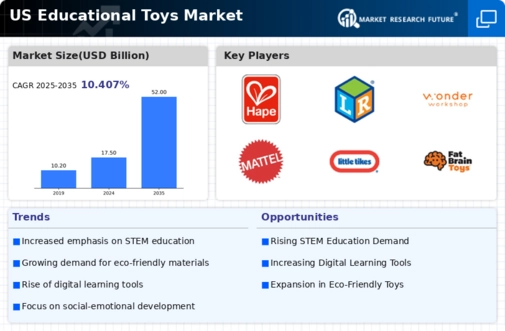The US Educational Toys Market is an evolving landscape characterized by innovative products that merge play with learning, catering to a diverse age range and developmental needs. Within this dynamic environment, companies strive to carve out their niche by developing unique offerings that appeal both to educators and parents, who increasingly seek toys that promote cognitive and social development. The market is marked by competition among established players and emerging brands, with an emphasis on sustainability, technology integration, and the endorsement of educational principles.
Factors such as changing consumer preferences, the rise of digital learning tools, and increased awareness of early childhood education contribute to the ongoing evolution of this market, shaping the strategies employed by manufacturers and retailers alike.Hape stands out in the US Educational Toys Market with its commitment to high-quality, eco-friendly educational products designed for children. The company emphasizes sustainable practices, using natural materials that are non-toxic and safe for children, offering a substantial competitive advantage as parents increasingly prioritize health and environmental considerations. Hape’s key strengths include a diverse product lineup that encourages creativity, problem-solving, and social interaction through play.
The company has successfully built a strong reputation in the market, recognized for its innovative designs that enhance the learning experience of children, making it a preferred choice for parents and educators seeking reliable educational toys in the US.Learning Resources has established a significant presence in the US Educational Toys Market with a wide array of educational products and resources designed to enhance learning through play. The company specializes in hands-on learning tools that promote critical thinking and STEM skills, showcasing its strength in developing products that align with educational standards.
Learning Resources is known for its engaging toys, such as counting games, science kits, and problem-solving activities, which cater to children across various age groups. Recent strategic initiatives, including partnerships and collaborations with educational institutions, have further solidified its position in the market. The company’s commitment to innovation is evident through continuous product development and enhancements, reflecting its focus on addressing the evolving educational needs of children in the US.

























